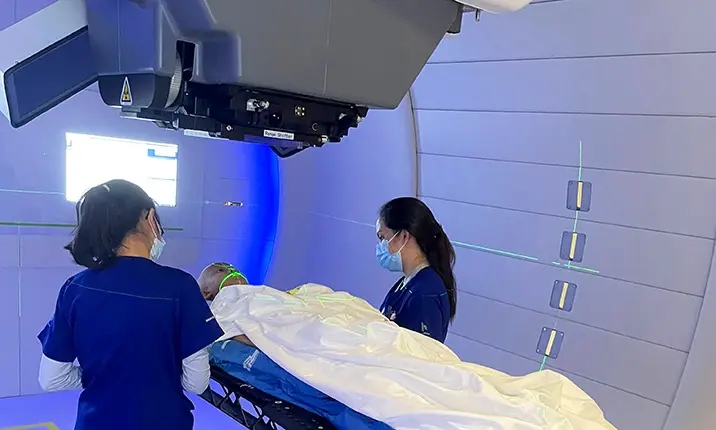-
-
Featured Care Areas


Targeting Cancer with the Precision of Proton Beams
Last updated: Tuesday, July 16, 2024 | 4 min reading time
10-year-old Jordan Tan underwent proton beam therapy – a type of radiation therapy to shrink his brain tumour while reducing the chance of damage to surrounding healthy tissues.
Jordan Tan lay still as the machine rotated around his body with its loud whirring noises. It was locking onto its target – the cancerous tumour in his brain.
The rotation stopped, and the machine shot an intense stream of particles to destroy the cancer cells.
The beam was so precise that its particles hit the tumour and did not travel beyond it. By sparing the other healthy brain cells from excess radiation, the beam reduced the 10-year-old’s risk of developing side effects like learning disabilities.
Jordan was undergoing proton beam therapy, a form of radiation therapy that complements conventional treatments like chemotherapy.
Proton beam therapy treatment improves a cancer patient’s quality of life, and its benefits include:
- Minimises radiation exposure of healthy tissues
- Fewer short and long-term effects
- Effective for complex tumours located near sensitive organs
- Can potentially reduce the risk of secondary cancers
Proton therapy at Mount Elizabeth
Mount Elizabeth Novena Hospital (MNH) opened the proton therapy centre on 11th May 2023. It is a S$78 million facility that took 5 years to plan for and is among the first of its kind among private hospitals in Southeast Asia.
Jordan had regular proton beam sessions at the hospital for 2 months, and the chatty boy never ceased to be fascinated by the futuristic-looking machine.
“The machine was humongous, and it could move (rotate) in an oval shape,” said Jordan. “It was not allowed to overheat, so the room was very cold. The nurses gave me several blankets and balloons filled with warm water so that I could be more comfortable.”
Protons vs photons
How is proton beam therapy different from conventional radiotherapy?
In radiotherapy, X-rays (photons) are delivered to the tumour and the tissue around it. However, the photons don’t just stop at the tumour; they go through the body and beyond the tumour.
As such, radiotherapy can harm surrounding healthy tissues and cause significant side effects such as fatigue, nausea, hair loss, cognitive impairment, hearing loss and skin changes.
On the other hand, proton beams target cancerous organs precisely, in turn reducing side effects and improving the patient’s quality of life.
Think of a proton beam as a laser pointer that illuminates only a specific area, while a radiotherapy beam is like a spotlight that casts light on a wider area.
A customised experience
The proton beam treatment requires detailed preparation.
To ensure accurate targeting of the tumour, Jordan underwent a CT simulation process. During this, the radiation therapy team took CT images of his body, and the radiation oncologist mapped the contours of the brain tumour and other internal organs for treatment planning. A physicist arranged proton beams from multiple directions to focus on the tumour with optimal intensity.
Special immobilisation accessories were also prepared to prevent movement during treatment. “On the first day, they made a headgear specially for me to keep my head still,” said Jordan. Proper positioning of his body and head ensured that the tumour was precisely targeted, minimising radiation exposure to surrounding tissues.
Finally, the radiation oncologist evaluated the treatment plan and activated the proton beams.
Jordan never felt alone during the proton beam therapy sessions. He said, “The nurses Mona and Elizabeth were really caring. They would make sure I was comfortable and chat with me through the microphone during the treatment as I was alone in the room.”
Seven months after the proton therapy ended, the boy was back on his feet.
He said, “I’m feeling better each day. I can now go to school and live a normal life again! I like to talk to my friends, cycle, swim, exercise, and play computer games.”
What patients can expect
At MNH, treatment will usually be carried out 5 days a week for up to 6 – 7 weeks. Each session lasts about 30 – 40 minutes, while the actual radiation takes only 5 minutes. Treatment is usually painless, and patients can resume normal activities after each session.
Proton beam therapy can be used to treat tumours in the head and neck, as well as prostate cancer. In patients below the age of 25, it can also be used for spinal and pelvic cancers.
Previously, patients in Singapore had to travel overseas to receive proton beam therapy, but the Mount Elizabeth Novena facility now allows them to rest in the comfort of their homes.
Learn more about proton therapy
Proton beam therapy is used to treat many cancers, often in combination with other treatments such as surgery and chemotherapy. It is also used to treat cancer that remains or comes back after X-ray radiotherapy.
In Singapore, MOH has stipulated an indication list allowing proton therapy for the following types of cancers:
- Brain tumours
- Head and neck tumours
- Liver cancer
- Lymphoma
- Oesophagal cancer
- Pituitary gland tumours
- Prostate cancer
- Sarcoma
- Spine tumours
Proton beam therapy may not be suitable for patients who are pregnant, or have systemic lupus erythematosus, scleroderma, and other connective tissue disorders
For more information, please visit this page.
Mount Elizabeth Cancer Care: Possible Starts Today
At Mount Elizabeth, we offer comprehensive care for cancer as well as brain and spine conditions, delivered by a compassionate and experienced team of medical oncologists, radiation oncologists, and neurosurgeons. Whether you’re experiencing persistent headaches or any health concerns, we're here for you.
Find a specialist









